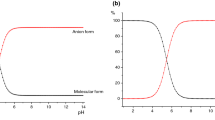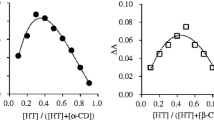Abstract
The limited applications of α-cyclodextrin (αCD) require elaboration of effective preparation procedures for inclusion compounds of this native macrocyclic host. The solid-phase guest exchange in anhydrous inclusion compounds with organic guests was used in the present work to activate the inclusion properties of αCD without the presence of water. The initial inclusion compounds and the products of this exchange process were characterized using thermogravimetry combined with mass spectrometry of evolved vapors (TG/MS) and powder X-ray diffraction. Solid-phase guest exchange in inclusion compounds of αCD enables encapsulation of organic guests in the higher amounts than can be achieved with a saturated hydrate of α-cyclodextrin under the same conditions. The developed guest exchange procedure does not demand optimization of components ratio and preparation conditions. The solid-phase guest exchange in one of the studied ternary systems produces an amorphous inclusion compound, which heating gives a true amorphous αCD without any traces of its crystalline phase. This is a first evidence of α-cyclodextrin amorphization without its complete dissolution, that can be used in practical applications where an amorphous state of this host is needed having a higher inclusion capacity than its crystalline forms.




Similar content being viewed by others
References
Crini G. Review: A history of cyclodextrins. Chem Rev. 2014;114:10940–75.
Hedges AR. Industrial applications of cyclodextrins. Chem Rev. 1998;98:2035–44.
Hădărugă NG, Bandur GN, David I, Hădărugă DI. A review on thermal analyses of cyclodextrins and cyclodextrin complexes. Environ Chem Lett. 2019;17:349–73.
Radu C-D, Parteni O, Ochiuz L. Applications of cyclodextrins in medical textiles—review. J Control Release. 2016;224:146–57.
Kfoury M, Auezova L, Greige-Gerges H, Fourmentin S. Promising applications of cyclodextrins in food: improvement of essential oils retention, controlled release and antiradical activity. Carbohydr Polym. 2015;131:264–72.
Brusnikina M, Silyukov O, Chislov M, Volkova T, Proshin A, Mazur A, et al. Effect of cyclodextrin complexation on solubility of novel anti-Alzheimer 1,2,4-thiadiazole derivative. J Therm Anal Calorim. 2017;130:443–50.
Sbârcea L, Ledeţi A, Udrescu L, Văruţ R-M, Barvinschi P, Vlase G, et al. Betulonic acid—cyclodextrins inclusion complexes. J Therm Anal Calorim. 2019;138:2787–97.
Gatiatulin AK, Osel’skaya VY, Ziganshin MA, Gorbatchuk VV. Smart control of guest inclusion by α-cyclodextrin using its hydration history. RSC Adv. 2019;9:37778–87.
Yoshii H, Furuta T, Yasunishi A, Hirano H. Minimum number of water molecules required for inclusion of d-limonene in the cyclodextrin cavity1. J Biochem. 1994;115:1035–7.
Gorbatchuk VV, Gatiatulin AK, Ziganshin MA, Gubaidullin AT, Yakimova LS. Unusually high efficiency of β-cyclodextrin clathrate preparation by water-free solid-phase guest exchange. J Phys Chem B. 2013;117:14544–56.
Gatiatulin AK, Osel’Skaya VY, Ziganshin MA, Gorbatchuk VV. Size exclusion effect in binary inclusion compounds of α-cyclodextrin. Phys Chem Chem Phys. 2018;20:26105–16.
Gatiatulin AK, Ziganshin MA, Gorbatchuk VV. Selective preparation of beta-cyclodextrin clathrates by solid-phase exchange of included tetrahydrofurane for volatile guests in absence of water. J Therm Anal Calorim. 2014;118:987–92.
Ho TM, Howes T, Bhandari BR. Encapsulation of CO2 into amorphous alpha-cyclodextrin powder at different moisture contents—Part 1: encapsulation capacity and stability of inclusion complexes. Food Chem. 2016;203:348–55.
Ho BT, Bhandari BR. Novel solid encapsulation of ethylene gas using amorphous α-cyclodextrin and the release characteristics. J Agric Food Chem. 2016;64:3318–23.
Armarego WLF, Chai CLL. Purification of laboratory chemicals. Boston: Butterworth-Heinemann; 2009.
Yakimova LS, Ziganshin MA, Sidorov VA, Kovalev VV, Shokova EA, Tafeenko VA, et al. Molecular recognition of organic vapors by Adamantylcalix[4]arene in QCM sensor using partial binding reversibility. J Phys Chem B. 2008;112:15569–75.
Gatiatulin AK, Ziganshin MA, Yumaeva GF, Gubaidullin AT, Suwińska K, Gorbatchuk VV. Using water-mimic organic compounds to activate guest inclusion by initially dry beta-cyclodextrin. RSC Adv. 2016;6:61984–95.
Topchieva IN, Tonelli AE, Panova IG, Matuchina EV, Kalashnikov FA, Gerasimov VI, et al. Two-phase channel structures based on α-Cyclodextrin–polyethylene glycol inclusion complexes. Langmuir. 2004;20:9036–43.
Ho TM, Howes T, Bhandari BR. Characterization of crystalline and spray-dried amorphous α-cyclodextrin powders. Powder Technol. 2015;284:585–94.
Kaminski K, Adrjanowicz K, Kaminska E, Grzybowska K, Hawelek L, Paluch M, et al. Impact of water on molecular dynamics of amorphous α-, β-, and γ-cyclodextrins studied by dielectric spectroscopy K. Phys Rev E. 2012;86:031506.
Frieler L, Ho TM, Anthony A, Hidefumi Y, Yago AJE, Bhandari BR. Crystallisation properties of amorphous cyclodextrin powders and their complexation with fish oil. J Food Sci Technol. 2019;56:1519–29.
Chacko KK, Saenger W. Topography of cyclodextrin inclusion complexes. 15. Crystal and molecular structure of the cyclohexaamylose-7.57 water complex, form III. Four- and six-membered circular hydrogen bonds. J Am Chem Soc. 1981;103:1708–15.
Acknowledgements
The work was supported by Russian Government Program of Competitive Growth of Kazan Federal University and by the subsidy allocated to Kazan Federal University for the state assignment in the sphere of scientific activities from the Ministry of Science and Higher Education of the Russian Federation (MSHE RF), No. 0671-2020-0061.
Author information
Authors and Affiliations
Corresponding author
Additional information
Publisher's Note
Springer Nature remains neutral with regard to jurisdictional claims in published maps and institutional affiliations.
Electronic supplementary material
Below is the link to the electronic supplementary material.
Rights and permissions
About this article
Cite this article
Gatiatulin, A.K., Osel’skaya, V.Y., Ziganshin, M.A. et al. Guest exchange in anhydrous inclusion compounds of α-cyclodextrin and its amorphization. J Therm Anal Calorim 146, 2417–2422 (2021). https://doi.org/10.1007/s10973-020-10428-0
Received:
Accepted:
Published:
Issue Date:
DOI: https://doi.org/10.1007/s10973-020-10428-0




